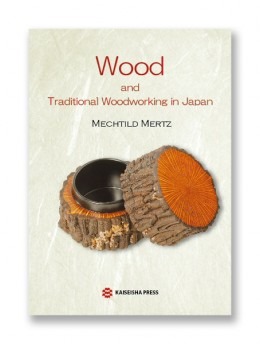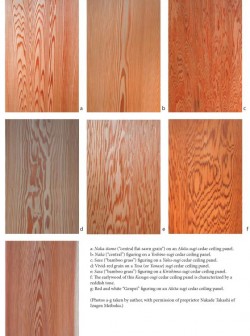Review by Douglas Woodruff

Wood and Traditional Woodworking in Japan by Mechtild Mertz. Otsu: Kaiseisha Press, 220 pp., ¥6,090.
[W]hile reading Mechtild Mertz’s Wood and Traditional Woodworking in Japan my initial reaction was visceral and immediate: why wasn’t a book like this available much earlier? For the past 30 years, my own experiences with Japanese woodworking jargon never seemed to move beyond an undersized and tangled thicket of inconsistent species identifications, wood characteristics, and woodworking terms all of which were available only in Japanese. This recent English publication brings a welcome clarity to many of those obscurities.
Personal interviews by the author with a down-to-earth group of 29 Japanese woodworkers are the core of this informative text and are, somewhat surprisingly to me, a pleasure to read. While the excellence of Japan’s decorative arts is all too evident, many Japanese craftsmen often tend toward a rarefied, if not altogether convincing, stance praising the sanctity and unassailable superiority of their techniques, materials and tools.

Woodworkers are no exception and can sometimes be as annoyingly pious in proclaiming the uniqueness of their craft. In this book, the culmination of a doctoral thesis, Mertz wisely focuses her questioning in a manner that lifts the subjective fog through which wood scholars and enthusiasts too often must sail. To her credit also is a stylistic decision to limit actual quotations from the interviewees in favor of folding many of their responses into a narrative text that makes for a smoother and more nuanced read. In summarizing her chapter on the cultural aspects of traditional woodworking, for instance, Mertz writes: “…it seems safe to conclude that almost all Japanese woodworkers show a preference for indigenous wood species. Although some of them gave rather vague reasons for their affection for Japanese wood, most of them based their preference on practical working experience. In my opinion, their preference for indigenous wood species does not necessarily reflect the superiority of Japanese wood over foreign, but rather reveals a symbiosis between the Japanese craftsman, his material, and the artifact which has developed uninterrupted over the centuries.”
Mertz has done an outstanding job of collating an enormous amount of data into a concise and clean format divided into six closely related chapters interspersed with elucidating tables, graphs, maps and illustrations. The book also includes a highly useful bibliography and set of multi-lingual appendices and a glossary which, for international wood devotees here in Japan, would alone be worth the book’s price. Except, perhaps, for the unfortunate mosaic of overlapping color photos in the first pages and the questionable choice of photos for the front and back cover, this is an excellent and long-overdue reference book that I would heartily recommend to anyone keen to know more about Japan’s culture of wood.
Readers interested in delving further into this fascinating world of wood science and related fields (especially those with Japanese reading skills) would do well to bookmark the catalog from Kaiseisha, Mertz’s publisher.
